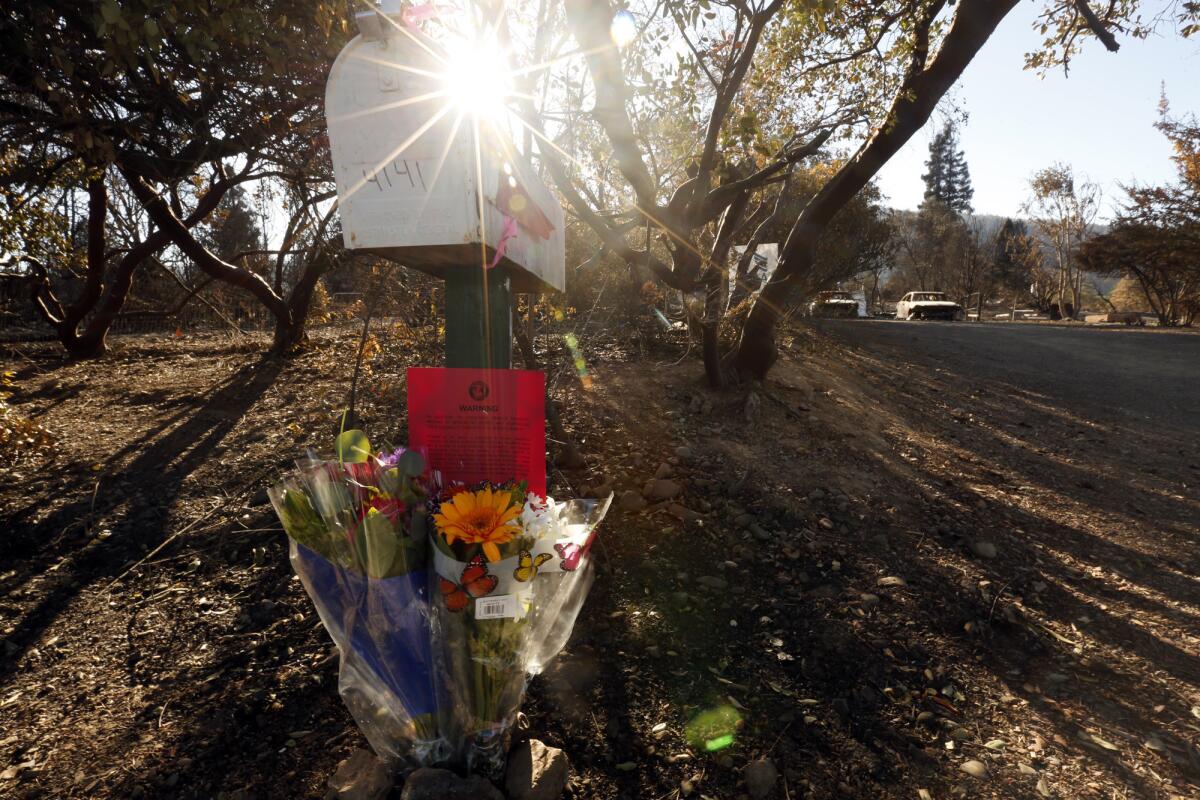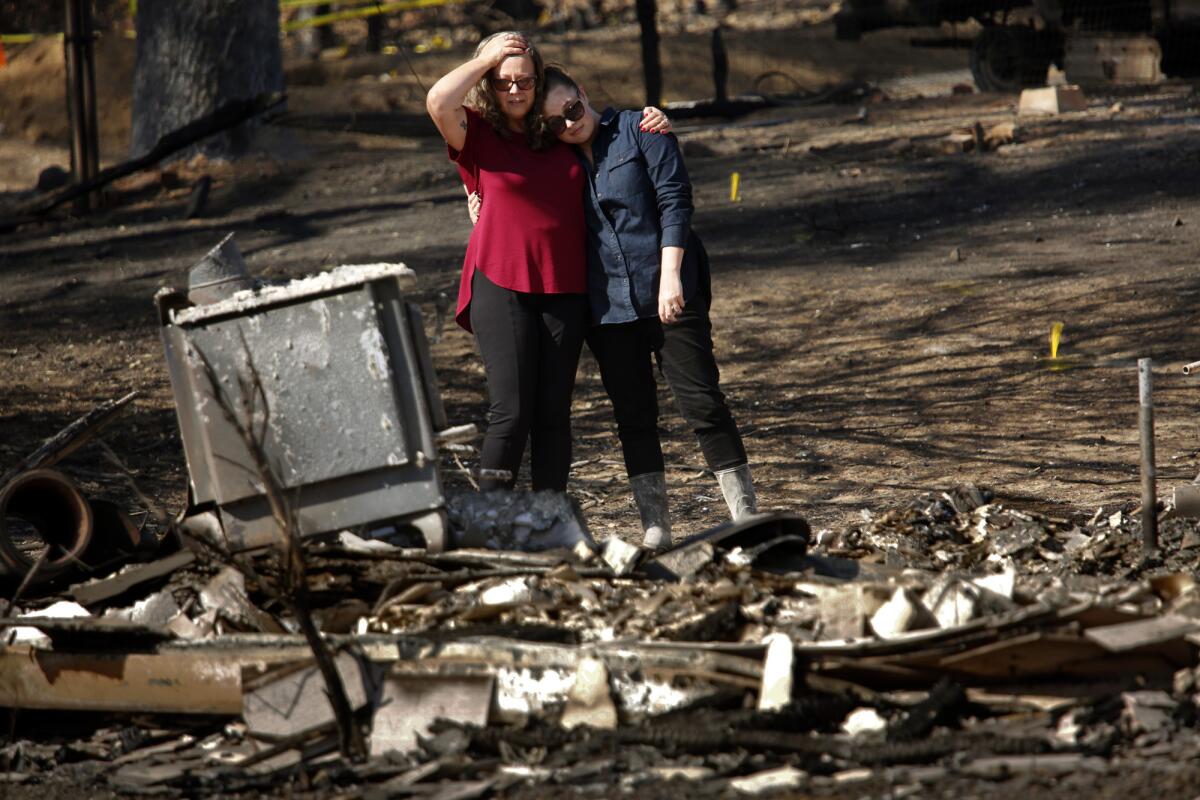As deadly fires burned Redwood Valley, delays, confusion about evacuation orders

- Share via
When the fire swept into Redwood Valley, Nick Ioimo was among the lucky.
He happened to get up around 1:20 a.m on Oct. 9 to use the bathroom and saw the flames. He and his wife managed to escape, but the elderly couple who lived behind them died in their home.
Nearly a month later, two things are clear to Ioimo, 69: “Nobody could have stopped that fire. But the people could have got out.”
The Redwood Valley fire killed nine people, all living on or near Tomki and West roads, which form the central north-south route in the rural Mendocino County valley. At least half died trying to escape on foot or in their cars.
The fire was one of more than a dozen wildfires spawned across Northern California that night as a windstorm toppled trees and power lines. In all, 42 people died and more than 8,000 homes were destroyed before the flames were brought under control.

An hour of chaos and confusion
Survivors such as Ioimo now ask whether more could have been done to warn residents of the encroaching fire. The sheriff has promised to provide a timeline of the key events on the night of the fire later this month.
But a Times review of police and fire dispatch calls that morning describe a chaotic scene in which officials debated when to send evacuation orders. The recordings provide an overview of communications that night as the fire swept through the valley but do not provide a full sense of what firefighters and law enforcement were doing on the ground. The county so far has declined to provide additional records.
The dispatches and interviews show the county issued an evacuation order in Redwood Valley more than an hour after the fire was first reported there. During that time, several Redwood Valley residents phoned 911 dispatchers to say they were trapped by fire.
Firefighters struggled with a lack of manpower and equipment in the rural county, which relies heavily on small fire departments and volunteers. State and local engines, including the Redwood Valley volunteer fire department, were sent to battle fires that had started earlier in the night in the adjacent Potter Valley. Multiple engines also were dispatched to an unconfirmed fire to the west that turned out to be a false alarm.
Mendocino County Sheriff Tom Allman declined to detail when and how decisions were made to tell Redwood Valley residents to leave. Allman said he has promised residents a detailed accounting of his department’s actions by Nov. 9.
The recordings reviewed by The Times suggest that in the chaos, there was at least some confusion about the evacuation plan.

‘Do we have an evacuation plan?’
The Redwood Valley fire was first reported at 12:35 a.m.
At 1:02 a.m., a California Highway Patrol officer asked dispatchers if evacuation orders were pending
“The winds are high, there are trees down and its jumping pretty quick,” he said.
At 1:10 a.m. a sheriff’s deputy called in reports of the fire’s fast advance.
“Do we have an evacuation plan? I’m at West Road at basically Sweetland and the fire is practically here,” he said.
The dispatcher said reverse 911 calls were being made, but it would be more than half an hour before residents in Redwood Valley received them.
At 1:17 a.m., a dispatcher communicated with at least one sheriff’s deputy in Potter Valley.
“We’re going to hold off on the reverse 911 until we get [the Office of Emergency Services] on the scene,” a dispatcher said, apparently referring to the Potter Valley area.
Another deputy who had been filing reports about the fire in Redwood Valley responded to that radio traffic. The deputy had been urging residents to flee the valley and sought more information from dispatchers.
“Are we clear at this point to do mandatory evacuations via PA?” he asked.
He was told an off-scene lieutenant “advised to hold off on the message on the reverse 911. [He] advised we need OES on scene to determine which safe direction they want to go to.”
“All right,” the Redwood Valley deputy answered. “I’ve given a few verbals but I’m advising people to move toward [Highway] 101 but I’ll stand by for further directions.”
At 1:43 a.m., the lieutenant arrived in Redwood Valley and learned incoming 911 calls included a woman trapped in her house on Tomki Road. He told dispatchers to activate an emergency warning.
“It’s pretty bad out here,” said Lt. Jason Caudillo.
In emailed responses to questions later, Caudillo said his decision to hold off on evacuations applied only to Potter Valley. He said he wasn’t aware of the Redwood Valley fire at that point and wanted to make sure there was a clear path for evacuations of Potter Valley residents.
“Potter Valley has only one main road in and out and the last thing we wanted was to evacuate our citizens into a firestorm.”

Some neighbors got out, others died
Homes were destroyed in Potter Valley, but no one died there.
Mendocino County’s two sheriff’s dispatchers were overwhelmed, Caudillo said. The task of sending out evacuation alerts fell to them, along with dispatching officers and taking 911 calls.
Carol Blair, also on Tomki Road, said she called those 911 dispatchers three times — at 1:45 a.m. to report flames surrounding her house, three minutes later when her cars caught fire, and a third time standing in the road with her husband, expecting to die.
Each time, she said, dispatchers transferred her to someone who could not help.
A passing neighbor rescued Blair and her husband. On the way out, at 2:09 a.m, her cellphone received a message. It was the evacuation warning.
Blair lost her home. The woman who lived two houses north of her died.
Katrina Frey, who manages a large vineyard at the north end of Redwood Valley, awoke by chance at about 12:30 a.m. and called 911 to make one of the first reports of the fire.
A houseguest who had left to avoid the smoke phoned a half-hour later to tell her Tomki Road was on fire. As Frey and 63 others caravanned out of the valley on a dirt road, others went south toward the fire to alert those unaware. One woman kicked in the door of a sleeping family’s home and pulled them out of the house as flames climbed the back wall.

‘The what-ifs will haunt you for your life’
In the wake of the fire, residents are debating what more could have been done to get word out.
Some residents question why warning sirens that sit behind the Redwood Valley fire station were never activated.
Prior to the fire, the sirens were tested every day at noon.
Members of the community advisory council said they had met privately with officials to ask about the silent sirens. They were told the sirens were once used to summon volunteer firefighters to the station, but that use had fallen by the wayside.
Council chairwoman Chris Boyd said she was told by the chief that the noonday test “was largely ceremonial.”
“People are upset about that alarm not going off,” said Ryan Nelson, 43, a Ukiah firefighter who lives in Redwood Valley.
He was among responders who at some point went door to door to wake residents. Nelson left his station about 2 a.m. — after evacuations were ordered — to check on his wife in Redwood Valley. He then teamed with a California Highway Patrol trooper going house to house to tell residents to leave, and wound up staving off fire from his mother’s house with her garden hose. Later still, Nelson was part of the team that found members of the Shepherd family, burned as they tried to flee on foot along Tomki Road, including two teens who died.
“You do the best you can and know inside yourself you did the best you can, and not ask the what-ifs,” Nelson said. “The what-ifs will haunt you for your life.”
Times staff writer Joe Mozingo contributed to this report.
More to Read
Sign up for Essential California
The most important California stories and recommendations in your inbox every morning.
You may occasionally receive promotional content from the Los Angeles Times.











